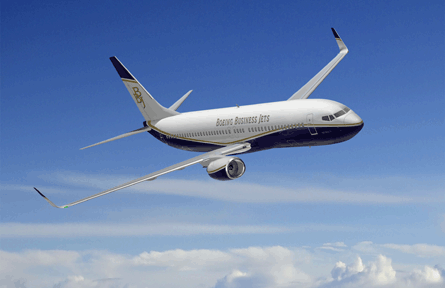Embraer introduced its new mid-light and mid-size jets to the world at the 2007 NBAA convention and in 2008 christened them, respectively, the Legacy 450 and 500. The Legacy 450 is the 500’s little brother; sharing the same wing, engines, empennage and cockpit. Their only major differences are the 450’s reduced cabin size and fuel capacity. The 450 is 1.06m (3ft 6in) shorter than the 500, reducing passenger cabin length. Unlike shrinks of many aircraft, the 500 was not shortened by removing a few frames. In an effort to keep cabin windows aligned with interior seating areas, the 450’s mid fuselage is an entirely new design. In a first for this segment, the 450/500 would have full fly-by-wire flight control systems.
From an owner’s standpoint, the passenger cabin is one of the most critical elements of a business jet. Size is important, and the 450 has on ovoid cross section and flat floor that offers stand-up height (1.83m). At its widest point, the cabin is 2.08m wide, wider than any Cessna, but slightly narrower than the Challenger 350. The 450 offers a club seating area at mid-cabin, with one seat forward and two aft, while the 500 typically seats eight. The 450 shares many cabin elements with the 500, each having an aft lavatory with externally serviced vacuum commode. Just aft of the lavatory is an in-flight accessible 0.99m3 (35.0ft3) baggage area. In both the 450 and 500, club seating areas are fully breathable, offering lie-flat beds. The cabins come with a Honeywell Ovation Select cabin management system as standard. Wireless CMS is via iOS devices, with wired controls at each seat. The preview flight’s 450 was a flight-test example without standard cabin fittings. I was able to tour a 500’s cabin at the factory – and found the appointments to be superb. Window placement relative to seating positions was good; there was no need to crane one’s neck to look outside.
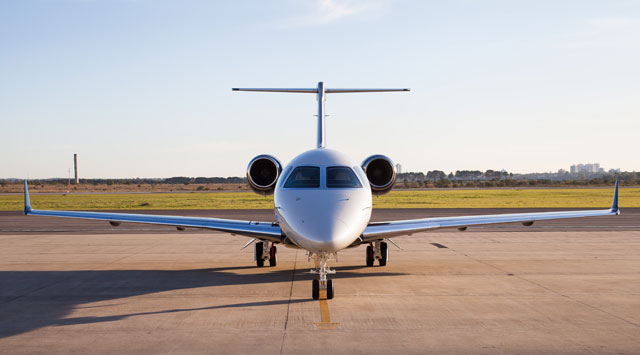
The Legacy 450 and 500 are Embraer's first fully fly-by-wire aircraft
Embraer
GLASS OFFICE
Passenger comfort matters, but as a pilot it’s what’s upfront that counts. In that regard, the Legacy 450 did not fail to impress. The Rockwell Collins Proline Fusion flightdeck is well arranged, with the instrument panel housing four 15.1in diagonal high-resolution displays. The displays are arranged in a “T” format with the base of the “T” at the forward edge of the centre pedestal. Each display can be segmented from full to 1/2 and 1/4 formats. Sidesticks are located on the leather-covered raised outboard consoles. System control panels are placed on the overhead panel, with each system’s panel logically arranged. System switches are primarily push buttons with some rotary knobs. The overall cockpit design philosophy is “quiet and dark.” The centre pedestal was well arranged, with an integrated control display unit for each pilot outboard of the thrust levers. Each CDU had a scratch pad, keyboard and cursor control device (CCD).
The 500 series are Embaer’s first fully fly-by-wire aircraft. All control surfaces are hydraulically actuated, with the exception of electric flaps and horizontal stabiliser. Three independent hydraulic systems ensure redundancy, with the electrically powered no 3 system primarily for back-up purposes. Pitch control is effected with two independent elevators, while yaw control is via a single rudder. For roll, the 450/500 has an aileron and three multifunction spoilers on each wing.
The fly-by-wire system has two main modes: direct and normal. As the name implies normal is the primary operational mode with direct mode as a back-up. In direct mode, flight control laws (FCLs) in pitch, roll and yaw are “stick to surface”, with speed-based gains. In normal mode (up and away) the pitch axis FCLs are Gamma Dot, pitch rate command. In most instances, a Gamma Dot scheme approximates a G command one. In roll the normal mode FCLs are pure roll rate command, while in yaw they are side slip (beta). The normal mode FCLs are designed to keep the 450/500 within its “normal” flight envelope (NFE). Embraer defines this as: +30º to -15º pitch angle, speed between 1.13VS and VMO, and less than 33º of bank.
There are a few exceptions to the above normal mode FCLs. The pitch laws vary for take-off and approach and landing. On the ground, normal mode roll laws revert to direct mode. Flight outside the NFE is allowed, with a number of envelope protection schemes installed: in pitch, AoA limiter, high speed protection, load factor limiter and low speed functions; in roll, bank limitations; and, in yaw, beta limiter and thrust asymmetry transient reducer. During my preview flight I would test nearly all of these protection schemes.
The 450 received certification from the Agência Nacional de Aviação Civil (ANAC) in Brazil and the US Federal Aviation Administration (FAA) in August 2015, about a year after the 500. Thrust from the Honeywell HTF7500E was up from planned, giving the 450 and 500 better take-off field performance. Better-than-planned aerodynamics, along with increased horsepower, pushed up high-speed cruise performance, while delivering longer than promised legs. The fly-by-wire controls allowed slower approach speeds and correspondingly shorter landing distances.
When Flight International was offered a flight in the 450, it was with great anticipation that I made the trek to Brazil to see if it handled as well as its numbers intimated.
COCKPIT FAMILIARISATION
Prior to my flight, I spent some time with Captain Luis Fernando C Berto, familiarising myself with the flightdeck. Berto guided me through FMS initialisation and pre-flight flows. He also showed me the electronic checklist and digital approach charts, which made the 450 a paperless aircraft. My preview flight was in the first prototype 450, registration PT-ZIJ. The flight was flown with Eduardo Camelier, chief legacy test pilot, from Embraer’s Gavião Peixoto facility. After settling into the lefthand seat, I adjusted the lefthand armrest so the sidestick fell comfortably to hand. The thrust levers, however, were mounted a bit too low on the centre pedestal for my liking.
Camelier guided me through the pre-flight preparations, using a paper checklist to confirm pre-start flows were accomplished. Starting the FADEC controlled engines was fast and easy. Post start checks were also easily accomplished. A slight bump in thrust was all that was needed to start the 450 rolling. Because of limited cockpit space, Embraer elected to forego a tiller, the steer by wire nosewheel steering controlled with rudder pedals. At speeds up to 10kt (19km/h), +/-62º of deflection is available, with authority decreasing as speed increases. We entered RWY02 at midfield and taxied to the approach end, where a tight 180º turn to line up took less than 10m of lateral offset to accomplish.
Flaps “2” take-off reference speeds for the 13,633kg (30,100lb with six occupants and 2,550kg of fuel) Legacy were V1/VR 113KIAS and V2 120KIAS. Once cleared by air traffic control, I released the brakes and advanced the TLs. About half way up the quadrant the auto-throttle (AT) engaged and moved the thrust levers to TO thrust of 87.4%N1. The NWS allowed me to track centreline as we briskly accelerated down the runway. When Camelier called “rotate”, about 5kg of aft sidestick was needed to set a TO attitude of 10º. Once airborne, Camelier raised the landing gear, and retracted the flaps as we climbed through 400ft AGL. During acceleration and clean-up sidestick forces in pitch were zero once the initial climb attitude was set.

Instruments include high-resolution displays
Embraer
CRISP ROLLS
Published data shows the 450 can climb directly to 43,000ft at maximum take-off weight, just short of its 45,000ft ceiling. As preview flight time was limited, we elected to stop our climb at 35,000ft. Test day restrictions prevented accurate climb data collection, but Embraer lists a time to climb of less than 11min and fuel burn 300kg for our configuration. During the climb, I did perform a number of bank-to-bank turns at bank angles of up to 60º, at speeds from 250 to 280KIAS. The Legacy’s roll FCLs are roll rate command when airborne. Commanded rate is proportional to sidestick displacement, with commanded rate ramping up to its maximum of 30º/s approaching full displacement. This increase felt natural and gave the 450 a very responsive feel. At all times I was able to capture desired angles of bank (AoB) with little effort. The banks were performed with my feet on the floor, the FCLs zeroing out any sideslip. During the climb, I also saw the roll axis bank limitation logic. If the sidestick is released with less than 33º AoB, current bank angle is maintained. At greater than 33º AoB, it will roll back to and hold 33º AoB, exhibiting positive spiral stability. While similar to Airbus fly-by-wire control logic, the Legacy can still do a complete 360º roll.
During the climb, I was also able to exercise the FMS. I found the CCD made navigation inside each display quite easy, handy for accessing menus and graphical flight planning. I was intuitively able to cue up and execute several Direct To legs, all on the MFD’s map display. Once level at 35,000ft I disconnected the AT and manually held Mach 0.772, long-range cruise speed. For test day conditions of ISA+10Cº, a total fuel flow of 850kg/h held 261KIAS with a resulting true airspeed of 454kt. Next I set maximum continuous power, 85.3% N1. The Legacy accelerated to and held M0.816 while indicating 278kt. True airspeed was 482kt with 1,030kg/h total fuel flow. Observed test day data on an ISA+10ºC day was better than Embraer’s published data.
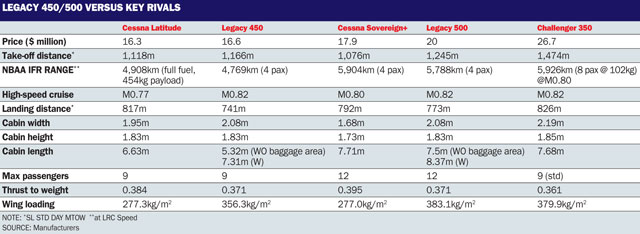
ENVELOPE PROTECTIONS TESTED
As mentioned earlier, the Legacy has many safety-enhancing envelope protection features. Most of these are resident in the pitch axis, offering protections at high and low speeds. The first is an attitude protection scheme that activates at pitch angles of +30º and -15º. This is not like the Airbus fly-by-wire scheme with absolute limits; rather it makes exceeding them more difficult. Outside the NFE in pitch, the Legacy’s FCLs feed back pitch attitude to move it back into the NFE. Release of the sidestick outside the NFE will cause pitch attitude to return to and stabilise at the appropriate limit. At high speeds the Legacy has an overspeed mode that allows flight past VMO/MMO (320kt/M0.83), but will prevent dive speed VD/MD (360kt/M0.90) being exceeded. After completing the work at 35,000ft, we descended at 300KIAS to a medium altitude block of 15,000-18,000ft. Passing 24,000ft I lowered the nose further and allowed the 450 to accelerate to 320KIAS. While ignoring the “over speed” warning, further acceleration to 326KIAS activated the protection mode, raising the nose. With this safety feature it would be difficult to inadvertently over speed the 450. With the over speed protection mode triggered, there is also a bank angle limiter. Slowing below 320KIAS, I rolled the Legacy into a 45º bank and lowered the nose. Passing 326KIAS, AoB was automatically reduced to 33º, even with full lateral sidestick input. At high speeds, centring the sidestick will allow the Legacy to roll wings level.
With high speed manoeuvring complete, we descended to 21,000ft for a wind-up turn to see if the NZ (G) maximum feature of the FCLs would prevent an over G. With power set at 280KIAS I rolled into 60º AoB descent. Increased aft sidestick held a constant speed as G load, displayed on a flight test gauge, increased to and stabilised at 2.5G. Even full aft sidestick would not increase the G loading. During a further descent to 15,000ft we looked at dual sidestick input logic and warnings. Sidestick inputs are summed; equal and opposite inputs yield a “null” input to the flight controls. Inputs in same direction are also added, with maximum that of a single sidestick input. Simultaneous displacement triggers an aural warning as well as a tactile one. With wings level, Camelier and I both put in opposite full deflection roll commands. While I did hear the aural warning, it was the vibrating sidestick that alerted me to the dual input. A sidestick priority button allows one pilot to take command in a dual input state.
Once level at 15,000ft, we investigated the low-speed protection schemes. The first one activates at 1.13VS. If the AP is engaged, the AT will engage and advance power to keep airspeed above 1.13VS. In manual flight, the pitch FCLs have positive speed stability. As the aircraft slows, the nose drops, requiring increased aft sidestick to maintain level flight. In normal mode with the AP off (gear down and flaps full), I slowed the Legacy from 130KIAS at 1kt/s. At about 100KIAS I noticed increased sidestick back pressure was needed to maintain level flight. Full aft sidestick slowed the Legacy to 89KIAS, where we settled into a stable wings level descent. The FCL’s AoA limiter was doing its job, not letting the aircraft slow below approximately 1.04VS. While still holding full aft sidestick, I rolled the Legacy into a 30º lefthand bank. Airspeed increased to 94KIAS, but the wings remained rock steady as our sink rate increased. Next, while still holding full aft sidestick, I put a full right roll input. The Legacy crisply reversed direction and I captured 30º of right bank. Even at these elevated AoAs the Legacy’s roll response was precise, with no yaw oscillations. The final low-speed event was an investigation of the AoA anticipation feature; designed to prevent rating through the AoA limit. While still fully configured at 120KIAS and 30º AoB, a full aft snatch of the sidestick generated a good initial pitch rate, slowing as we approached the limiting AoA. Once the FCLs determined we were not going to rate through the limit, the pitch rate then increased. The AoA anticipation scheme along with AoA limiter had allowed me to manoeuvre the Legacy aggressively at slow speeds, a great capability to have for CFIT avoidance and windshear recovery.
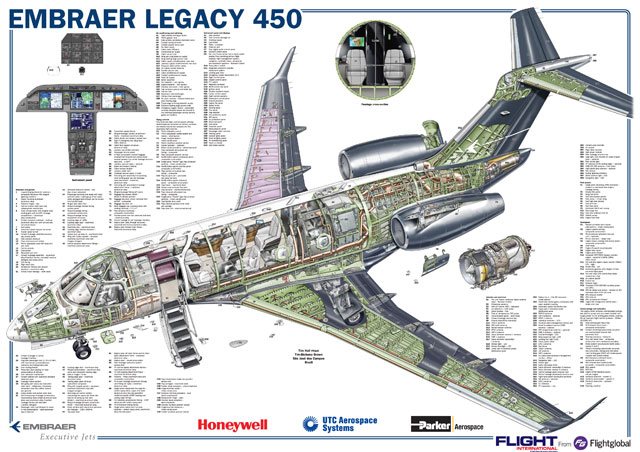
Click here to enlarge and purchase this cutaway
ENGINE OUT
Up to that point my evaluation had concentrated on the pitch and roll axis handling qualities of the Legacy. Adverse yaw when rolling and Dutch Roll oscillations in a conventional aircraft show that roll and yaw axes are coupled. For the most part, however, the Legacy’s are uncoupled. In the clean configuration, the FCLs did a fine job of countering adverse yaw and dampening out any Dutch Roll oscillations.
Next, I would see how the Legacy responded when deliberately exercising the yaw axis. The first exercise was in a gear down and flaps full configuration at 110KIAS. In normal mode, I gradually input full left pedal (rudder). With the sidestick free, the Legacy gently rolled to and maintained an 8º AoB to the left with a like amount of sideslip, demonstrating conventional roll due to yaw characteristics. Holding the wings level with lateral sidestick allowed up to 12º of beta to develop, showing the Legacy could be sideslipped like a conventional aircraft.
The next manoeuvres were designed to highlight how the Legacy would respond to an engine failure. These were done with the gear up and flaps 2. To show that the 450 was at its core a conventional aircraft, Camelier put the 450’s flight controls into direct mode. Power was set to 88%N1 (take-off power) on both engines and a climb established. With my hands and feet off the controls, Camelier rapidly retarded the right thrust lever to idle. Just like a conventional aircraft, the Legacy yawed to the right and started an unabated right roll. After rolling wings level, the flight controls were restored to their normal mode. The Legacy has a thrust asymmetry transient reduction scheme, designed to aid pilot recognition of an engine failure. With power set to 88%N1, Camelier again pulled the right thrust lever to idle. The FADEC sensed the thrust asymmetry and reduced the amount of allowed sideslip. This time, the right wing dropped less than 5º, with only 2º of sideslip. Like an Airbus, to improve climb performance, the Legacy’s PFD slip indicator depicts an optimum sideslip angle. By allowing some sideslip there is less cross control and less performance degradation. The 450’s benign response to an engine loss gives the pilot ample time to respond, while optimum beta guidance improves climb performance.
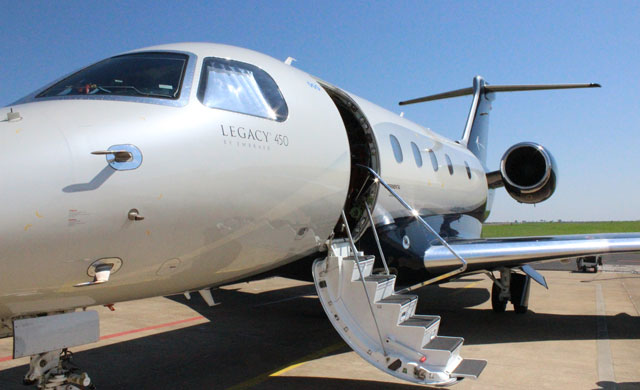
Passengers will appreciate the quiet stand-up cabin
Embraer
TCS FOR LANDING
With increasing automation, one of the few times a pilot may hand-fly the aircraft is in the landing pattern. After finishing the area work, we turned towards Gavião Peixoto for recovery. At altitude I had found the Legacy’s handling qualities quite pleasant, allowing for crisp predictable control throughout its speed envelope. While I expected to find the same in the landing pattern, there were differences in the pitch FCLs that piqued my interest. With the gear down and flaps 3 or full (landing configuration), artificial speed stability is added to the pitch rate command scheme. A trim control speed is set when landing configuration is entered. Sidestick deflection still commands pitch rate, but there is no auto trim to maintain pitch attitude. Back-up pitch trim switches are mounted on the pedestal for use in direct mode and for setting take-off trim. To relieve forces, a sidestick-mounted TCS thumb switch resets the trim reference speed, which is displayed as a green arrow on the airspeed tape. The Boeing 777 also has apparent speed stability, but with yoke trim switches to set TRS. While TRS is not shown to the Boeing 777 pilot, I did anticipate flying the Legacy on final approach would be an intuitive task just like in the Boeing 777.
We did two touch-and-go approaches to RWY02, the first with flaps “3” and the second flaps full. The pitch FCLs changed to TCS when the flaps were extended to “3” at 150KIAS, on straight-in final. Slowing to the target speed of 118KIAS required constant aft sidestick pressure, periodically relieved by depressing the TCS switch. Once “on speed” I hit the TCS switch one last time, and flew the approach with a fixed TRS. Target speed deviations were easily recognised as sidestick pressure was needed to maintain the desired aim point. While I did jockey the thrust levers a good bit on final, the FCLs compensated for the varying pitch forces caused by the high-mounted engines. When “30” (30ft radar altitude) was announced, I retarded both thrust leverss to idle and started the flare. With TRS set at 118KIAS, less than 5kg of aft sidestick pressure was needed to capture and maintain the touchdown attitude. The Legacy settled nicely on the runway, the trailing-link main landing gear ensuring a soft touchdown. The pitch FCLs exited the TCS mode and entered their de-rotation mode. In that mode neutral sidestick lowers the Legacy’s nosewheel to the runway at a 2º/second rate. It worked fine, the de-rotation feeling as normal as any I had done in a number of other aircraft.
While rolling down the runway I advanced the TLs and Camelier set the flaps to “2” in preparation for the “go” part of the touch and go. At 118KIAS Camelier called “rotate,” the Legacy leaping off the runway at our light weight. A visual circuit was flown, with our final flap setting of full set on the base to final turn. On final I slowed the Legacy to out target speed of 108KIAS and set the TRS there. Other than a lower pitch attitude on final and slightly lower flare attitude, this approach was just like the prior flaps “3” one. This too was a touch and go, and with flaps set to “2” and TLs advanced, we climbed off the runway for another visual circuit.
I had started to feel quite comfortable with the Legacy, but Camelier would soon up the ante. Shortly after the gear was retracted, he retarded the left thrust lever to idle, simulating an engine failure. Initially I countered the slight yawing motion with right pedal, and levelled the wings. Once stable, I used the PFD’s beta cue to fine tune rudder deflection. Less than 20kg of pedal force was needed to keep the beta cue centred for the climb to pattern altitude, where the engine out exercise was terminated. While it took me by surprise, as had been the case at altitude, the Legacy’s response was as gentle as a kitten.
LONDON CITY HERE WE COME
My third approach in the 450 was a visual steep approach to RWY02, simulating one into London City airport. The approach there has a 5.5º descent path. The 450 has a dedicated steep approach mode, and an amber “steep” is presented in the PFD when armed. Extending the flaps to full engages the mode, steep now green. In the steep mode the spoilers are deployed to a dynamic mid position as determined by estimated aircraft weight. With gear down and flaps full I flew towards the runway at 1,500ft AGL, and started a descent at about 2.2nm from the threshold. Camelier had set -5.5º reference line in the PFD, and once pointed at the aim point (normal TDZ) the aircraft nicely settled into a 5.5º descent path. Target speed was 114KIAS (VREF+10kt) in this instance. The FADEC-controlled engines allowed me to stay on speed, while the Flight Control synoptic showed about 1/2 MFS extension. I pushed the nose over to increase airspeed, and the MFS extended further to slow the descent. Pulling the nose up caused the spoilers to retract slightly. Next I levelled the aircraft to intercept and track a 7.5º descent path. The spoilers were nearly fully extended, but the 450 was rock steady as it tracked the off-condition steep path at 114KIAS.
At about 500ft AGL I recaptured the 5.5º descent path and concentrated on airspeed and aim point. I started the round out when “50” (50ft RA) was announced, retarding the thurst levers to idle at 20ft RA. The flare and touchdown were unremarkable, in that it was nicely paced with no ground rush. As with prior landings, the landing gear ensured a smooth touchdown. Once on the ground, the steep mode was automatically exited.
After a routine take-off and climb to downwind, Camelier put the 450’s flight controls into the DM by depressing a guarded pedestal push button. This approach would be flown with back-up FCLs to a full stop landing. I was prepared for the worst; hoping it wouldn’t be like a “dampers off” approach in an F-111, which can be likened to flying a bowl of jelly. In actuality the 450 now flew like a conventional aircraft. As the aircraft slowed, I used the back-up trim switches to “trim off” sidestick forces, changes in power requiring changes in pitch trim. With flaps full, a target speed of 114KIAS was held on final. In direct mode there is a yaw damper, which did a good job of damping out gust-induced oscillations on final. That being said, it was not as smooth as the earlier normal mode approaches. Reducing power at 30ft RA caused the nose to rise, helping initiate the flare. After a soft touchdown, the spoilers extended and the auto brakes engaged to slow the aircraft. At 20kt I disengaged the auto brakes and turned off the runway for the short taxi to the ramp. Shutdown and post flight procedures were easily accomplished.

HARD NUMBERS, GOOD FEELINGS
The Cessna Latitude was the last mid-light jet I had flown prior to the Legacy 450. Both aircraft fit neatly into that segment with differing strengths. The Latitude costs less and goes further. The 450 costs a bit more and goes a good bit faster. According to Embraer the 450 has lower direct operating costs, and its faster cruise speed means it is even more economical to operate than the Latitude. While the Latitude is a very capable aircraft, from this pilot’s perspective the differences are generational. The Latitude is a Sovereign with a larger diameter (and shorter) fuselage, an aircraft designed over a decade ago.
The Legacy 450 and 500 are clean-sheet designs employing state-of-the-art technology. Embraer is by no means the first to field a fly-by-wire business jet, but it is the first to do so for less than $20 million. During my 2h flight I was able to push the Legacy 450 to the edges of its envelope and see first-hand how its numerous safety-enhancing features allowed for true care-free handling. Throughout the envelope its fly-by-wire control scheme gave precise predictable responses to pilot inputs. I found its sidestick had a good feel to it – aircraft responses were proportional to stick deflections/forces. I also liked the auto-throttle and back-driven thrust levers. Owners will appreciate the 450’s low direct operating costs, passengers the quiet stand-up cabin, and pilots the crisp, care-free handling qualities of this paradigm-shifting fly-by-wire business jet.
Source: FlightGlobal.com






















